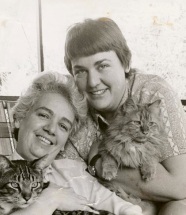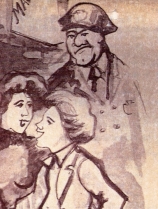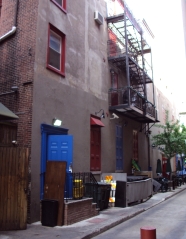 |
| Philadelphia lesbian feminist newspaper Wicce, featuring Rusty Parisi (1974) |
Location: Corner of Quince and Walnut Streets, Philadelphia, Pennsylvania, USA
Opened: 1963
Closed: Early 1970s
We get our introduction to Rusty's from the Timeline of Lesbian/Queer History in Philly:
1963: Rusty’s, the first lesbian bar in Philadelphia located behind where Moriarty’s Irish Pub now resides, begins to gain in popularity. The bar was named after Rusty Parisi, who was one of the first lesbian bar owners in the city.
We're also informed from the same source of the following:
On March 8, 1968, Rusty’s gets raided, and many women were verbally abused by officers.
But more about that raid later.
Here's a quite detailed history of Rusty's from the Philadelphia Gayborhood Guru:
About 1963, the bar [known as the Star Lite Café] became known as Barone’s Variety Room. The main entrance to the restaurant and bar was on Walnut Street, but if you went around to the Quince St. side of the building, through the side door and up the stairs, you were in Rusty’s.
In November of 1967, Philadelphia Magazine published an article by Nancy Love called “The Invisible Sorority,” a semi-lurid exposé on Philadelphia’s lesbian community. The article opened with a visit to Rusty’s:
The woman at the door in the button-down shirt might have been Rusty Parisi, owner of the bar. She is the woman in glasses on the cover of the Philadelphia lesbian feminist newspaper Wicce, above. This issue, published in 1974, featured an interview with Rusty and a nostalgic look back at lesbian life in the ’60s. Rusty was one of the first bar owners in Philadelphia who was gay herself. She discussed butch and femme roles, police harrassment and her own experiences. When asked how she felt about men in general, she replied bluntly, “I’ve never been with one and I’d never want to be. So that’s what I think of men in general. Not much.”
A small sign over the door on Quince Street, a little alley next the Forrest Theatre, says “Variety Room.” It’s very quiet as you go up the old wooden steps to the second floor and down the long corridor. You don’t hear the juke box until you’re actually in the room. You pay the $2 minimum to a woman in a white button-down shirt and slacks who looks a little like a gym teacher you once had, and she gives you a strip of tickets for drinks. It’s a smallish panelled room with a bar at one side and lots of tables clustered around a dance floor. At first, the relaxed atmosphere and informal dress and young girls make you think of a girls college hangout in a small town.
Matchbook covers from Barone's (Rusty's)
The matches, above left, are from the cigarette machine in Rusty’s. With their 1960s pin-up girls and phallic rockets, (the one on the right is limp!), they are two of my favorite objects in the William Way Community Center’s archival collections.
And from the same source we learn more about that raid:
 |
| Ada Bello and Frances Hanckel |
 The local chapter of D.O.B. editorialized against the raid. D.O.B., the “Daughters of Bilitis,” was a national lesbian social and support organization with a policy of political non-involvement. The Philadelphia chapter was one of the exceptions. A few nights later, after another raid on Rusty’s, local activists Ada Bello, above, on the left, seated next to Frances Hanckel, right. Lourdes Barbara Gittings were present. When Police asked Gittings for her I.D., Barbara flashed her ACLU card. The police moved on.
The local chapter of D.O.B. editorialized against the raid. D.O.B., the “Daughters of Bilitis,” was a national lesbian social and support organization with a policy of political non-involvement. The Philadelphia chapter was one of the exceptions. A few nights later, after another raid on Rusty’s, local activists Ada Bello, above, on the left, seated next to Frances Hanckel, right. Lourdes Barbara Gittings were present. When Police asked Gittings for her I.D., Barbara flashed her ACLU card. The police moved on.
 |
| Entrance to the former Rusty's, now Moriarty's Irish Pub |
In May, the D.O.B. arranged a meeting with the Philadelphia Police Inspector and they brought along an ACLU observer. The D.O.B. let the Inspector know that they represented the community and that they were were not afraid to protest violations. The police issued a statement that “homosexuals have been, are now, and will be treated equally with heterosexuals.” Because of their active support in the incident, membership in the Philadelphia D.O.B. increased dramatically. A year before the Stonewall riots, the raid on Rusty’s and the reaction of local lesbians was a success story for gay rights.
 |
| Moriarty's Irish Pub |
The Box Turtle Bulletin also had an excellent description of this raid. Do check it out.
There is also a passing reference to Rusty's at the University of Michigan Lesbian History site:
“Barone’s,” also known as “Rusty’s” developed into a definitely lesbian, sub-cultural space. Crossing the threshold into Rusty’s, you entered the “inside” world. Inside Rusty’s, lesbians were able to define themselves through community and public space. Lesbians called each other “Brothers,” and protected each other from police and straight male harassment. There was a tendency not to welcome men into lesbian bars, but a few gay men would attend.
According to this account, it wasn't just a case that men weren't "welcome" in Philadelphia's lesbian bars. In fact, it is claimed that there were out-and-out turf wars, with "diesel dykes" beating up men (even gay men) who were perceived as territorial invaders. Such a contrast to today, when lesbians have (apparently) become such marshmallows:
 |
| Rusty's back in the day |
In the 1950's and 60's, Camac Street and its environs, especially around the area of Spruce Street, were sometimes the scene of conflicts between gay men and lesbians. The gay men would be walking up Spruce Street at night (for decades considered the area where most of Philadelphia's Center City gays and lesbians could be found), and sometimes were mistaken for straight or gay men invading "lesbian turf." While I was conducting research for Gay and Lesbian Philadelphia, local personality Henri David told me that some "strong looking diesel dykes" would occasionally beat up gay men who wandered into certain areas thought to be lesbian territory. This didn't happen often, David assured me, but it did occur. Many of the gay men were from the city but many more were from the suburbs--and may have taken the same train that [Christopher] Isherwood took to spend a night at the Camac Baths.
Lesbians came in from different parts of the city as well, although women traveling late at night often had to go to unusual lengths to protect themselves against predatory men. Marge McCann, a Germantown resident who ran unsuccessfully against Clark Polak for the presidency of the Janus Society, an early homosexual rights group, recalled taking the Broad Street subway at night disguised as a boy. McCann would slouch down in the subway seat and adopt a tough pose: this was her ticket back and forth to the city's only lesbian bar at the time, Rusty's.
Rusty's was near Philadelphia's infamous TROC burlesque theater, near 10th and Race Streets, and had the paranoid atmosphere of a 1920's speakeasy.
Patrons who went to Rusty's had to peer into a peephole in order to be admitted. Joan C. Meyers, an art student and photographer living in Center City at the time, recalls that she was turned away from Rusty's because she was not dressed in a "lesbian uniform," that being short hair with no make-up.
Meyers said that her flowing Joan Baez locks caused Bee, a staff person at Rusty's, to say: "We are tired of straight women like you coming around bothering our girls."
According to the book Gay and Lesbian Philadelphia (2002), Rusty's went out of business in the early 1970s, "when patrons tired of sneaking through back alleys to request permission through a peephole."
Another thought: Notice how Rusty's was located on the second floor. This is a surprisingly common spatial pattern among women's spaces. In fact, it was a pattern that was typical among the old "ladies restaurants" and "ladies dining rooms" of the 19th century. That's one reason I think there is a lot of overlap between these seemingly distinct and different places.

No comments:
Post a Comment
Note: Only a member of this blog may post a comment.